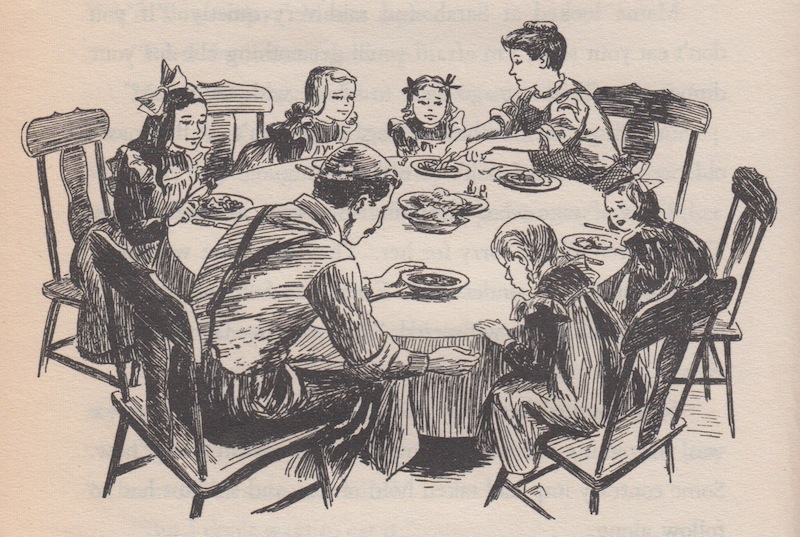
All-of-a-Kind Family did for Jewish-American cuisine what the Little House books did for pioneer cooking.
I grew up in a household where we didn’t give food much thought. We didn’t make pilgrimages to particular restaurants or rhapsodize about long-deceased relatives’ signature dishes. I don’t have aromatic memories of cozy cooking lessons with my mother, peppered with life advice. For my parents, practical-minded immigrants from Korea, the purpose of food was wholly unromantic: you ate so you wouldn’t be hungry.
The idea that food was more than something to fill your stomach came to me through books. There would be a moment in a novel where the characters ate some exotic (or exotic to me, at least), delicious-sounding morsel and I’d become entranced. I’m not just talking about the roasted pig’s tail and the green pumpkin pie from the Little House books. Or the cold meat pie from Danny the Champion of the World. Those books were just the start.
1) The mulligan stew from The Boxcar Children
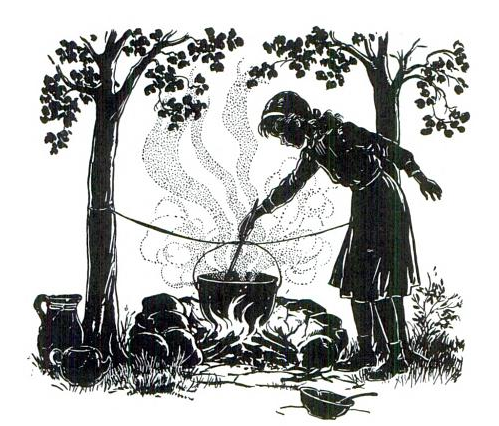 When we first meet the plucky orphans, all they have to eat are a couple of loaves of bread. But as their fortunes improve, they go from eating just bread, to bread and milk, to bread, milk, “fine yellow cheese” and wild blueberries. Each humble new addition to their pantry is an occasion for celebration. And when scrappy 12-year-old chef Jessie manages to cook a stew from some scrounged up carrots, onions and turnips and a piece of dried meat, it signifies that the boxcar has become a true home.
When we first meet the plucky orphans, all they have to eat are a couple of loaves of bread. But as their fortunes improve, they go from eating just bread, to bread and milk, to bread, milk, “fine yellow cheese” and wild blueberries. Each humble new addition to their pantry is an occasion for celebration. And when scrappy 12-year-old chef Jessie manages to cook a stew from some scrounged up carrots, onions and turnips and a piece of dried meat, it signifies that the boxcar has become a true home.
Jessie cut the tops off the vegetables and washed them in the brook. “I’ll put them in after the meat has cooked awhile,” she said. Soon the water began to boil, and the stew began to smell good. Watch sat down and looked at it. He sniffed hungrily at it and barked and barked. The children sat around the fireplace, eating bread and milk. Now and then Jessie stirred the stew with a big spoon. “It will make a good meal,” said Henry.
2) The goat’s milk cheese in Heidi
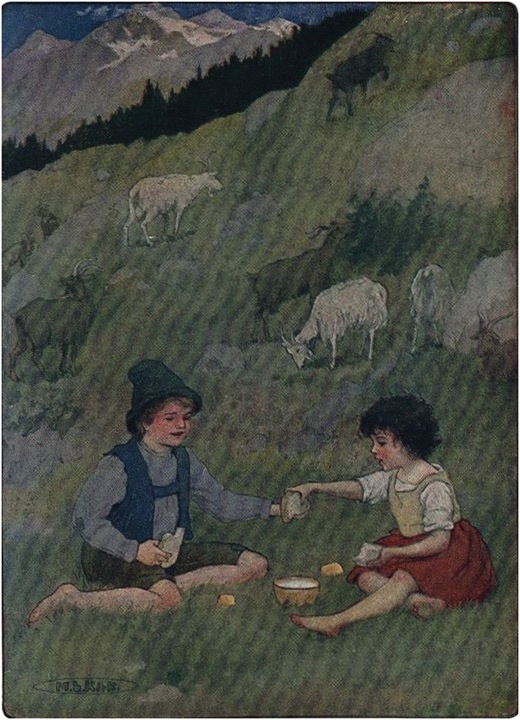 These days a lot of people will tell you that that dairy (like wheat) is the devil. But Heidi seems awfully healthy. The only food her iracible, goat-herding grandfather seems to feed her is bread with toasted cheese, but it’s magical stuff.
These days a lot of people will tell you that that dairy (like wheat) is the devil. But Heidi seems awfully healthy. The only food her iracible, goat-herding grandfather seems to feed her is bread with toasted cheese, but it’s magical stuff.
As the pot began to sing, he put a large piece of cheese on a toasting fork and moved it to and fro in front of the fire until it became golden yellow all over. She ate her bread and cheese, which tasted delicious, and every now and then she took a drink. She looked as happy and contented as anyone could be.
And the bubbly, fresh milk! Heidi declares it “the best milk I’ve ever drunk” and guzzles it by the mugful. (It’s always a mug, never a glass.)
Clara had never tasted goat’s milk, and she sniffed at it uncertainly, but when she saw how quickly Heidi was emptying her mug, she began to drink too, and thought the milk tasted as sweet and spicy as if it had sugar and cinnamon in it. “Tomorrow we shall drink two mugfuls,” said Uncle Alp.
Toward the end of the book, the clean mountain air and all-dairy diet even cures Heidi’s sickly city friend, Clara.
3) The roasted chickpeas in All-of-a-Kind Family
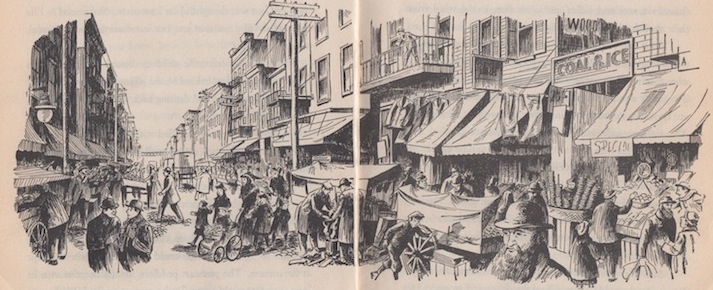 To this day anything I know about gefilte fish, hamentashen or teiglach I learned not from my Jewish in-laws but from author Sydney Taylor. It’s hard to choose just one food moment from this series, as all five of the All-of-a-Kind Family books are filled with mouthwatering descriptions of meals. But the first book has a vivid chapter where Mama takes the girls food shopping at the Rivington Street market. The road is choked with pushcart peddlers and “the delicious odor of sour pickles mingled with the smell of sauerkraut and pickled tomatoes and watermelon rind.” Each girl gets to spend a penny on a treat; Sarah chooses the roasted chickpeas:
To this day anything I know about gefilte fish, hamentashen or teiglach I learned not from my Jewish in-laws but from author Sydney Taylor. It’s hard to choose just one food moment from this series, as all five of the All-of-a-Kind Family books are filled with mouthwatering descriptions of meals. But the first book has a vivid chapter where Mama takes the girls food shopping at the Rivington Street market. The road is choked with pushcart peddlers and “the delicious odor of sour pickles mingled with the smell of sauerkraut and pickled tomatoes and watermelon rind.” Each girl gets to spend a penny on a treat; Sarah chooses the roasted chickpeas:
Everyone watched as he fished out the peas. First he took a small square of white paper from a little compartment on one side of the oven. He twirled the paper about his fingers to form the shape of a cone and then skillfully twisted the pointed end so that the container would not fall apart. He lifted the wagon cover on one side revealing a large white enamel pot. The steam from the pot blew its hot breath in the little girls’ faces so they stepped back a bit while the peas were ladled out with a big soup spoon. The wagon cover was dropped back into place and the paper cup handed over to Sarah. The peas were spicy with pepper and salt, and how good they were!
When I first read this, I didn’t have the faintest idea what a chickpea even was. But I was mesmerized.
4) The toasted bread with butter and sugar in The Great Brain
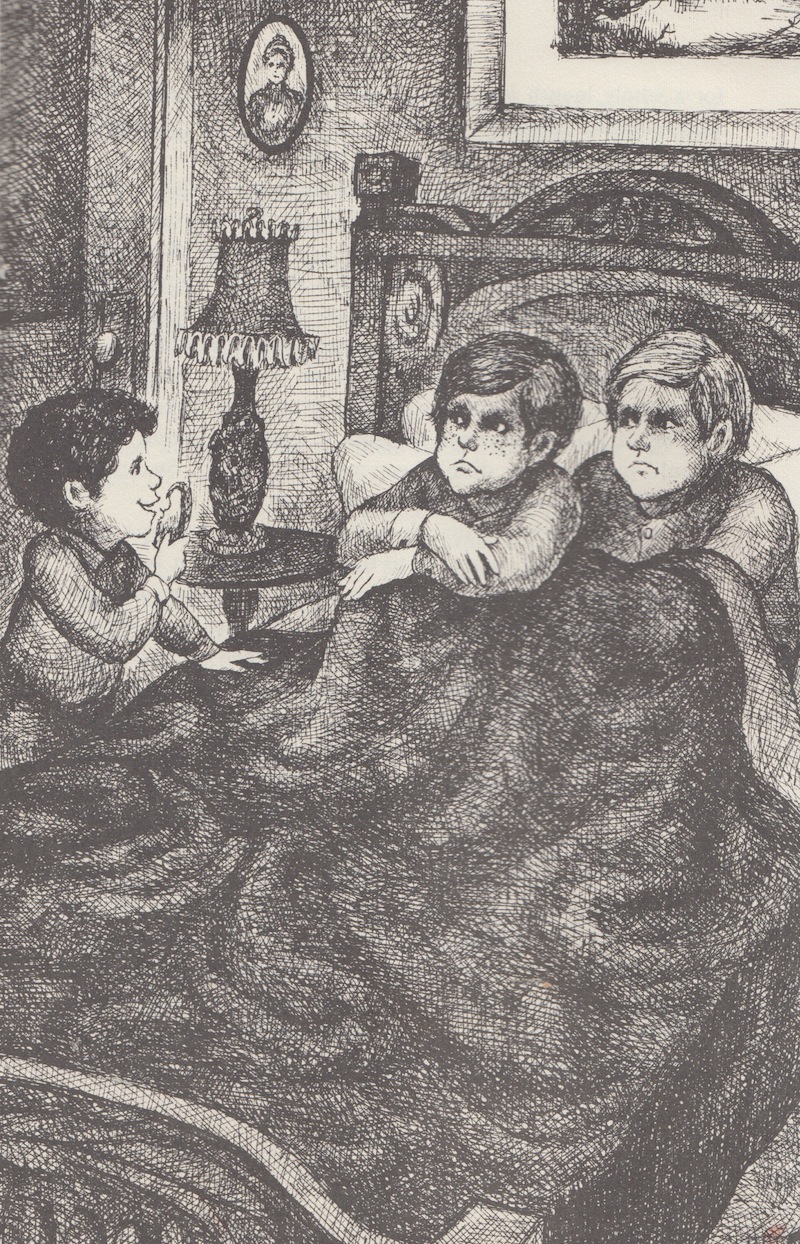 My brother and I were obsessed with The Great Brain series, which was set in a small town in Utah in the 1890s. All that mysterious tension between the Gentiles vs the Mormons and the boys constantly telling each other “I’ll whip you good!” (these kids were always beating each other to a pulp) was utterly fascinating. I was also struck by how simple yet delicious all the food always sounded. Mamma was always cooking and baking, and the three boys were constantly “gorging themselves” on fried chicken, roast beef sandwiches, hard-boiled eggs, and pie. But this description of the toasted bread, butter and sugar was the ultimate:
My brother and I were obsessed with The Great Brain series, which was set in a small town in Utah in the 1890s. All that mysterious tension between the Gentiles vs the Mormons and the boys constantly telling each other “I’ll whip you good!” (these kids were always beating each other to a pulp) was utterly fascinating. I was also struck by how simple yet delicious all the food always sounded. Mamma was always cooking and baking, and the three boys were constantly “gorging themselves” on fried chicken, roast beef sandwiches, hard-boiled eggs, and pie. But this description of the toasted bread, butter and sugar was the ultimate:
Mamma made fresh bread that day. If there was anything my two brothers liked the most, it was to take the heel of a fresh-baked loaf of bread, smother it with butter and sugar, and then put it in the oven until the sugar turned brown. It was better than candy. I entered the bedroom with a heel of bread covered with butter and toasted sugar.
“I thought I’d have a little snack before going out to play,” I said as I waved the heel of bread back and forth so they could smell it. Then I took a bite out of it. “Boy is this delicious. Don’t you wish you could have a bite?”
My brother and I would often try to replicate this treat using a heel of store-bought “French Bread” from the supermarket, but it never came out the way we imagined it should.
5) The beaver family’s fish dinner in The Lion, the Witch and the Wardrobe
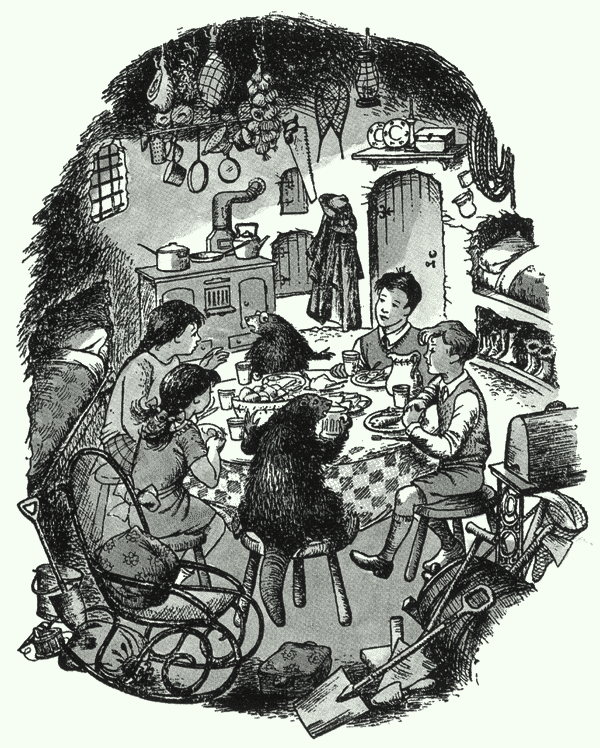 That enchanted Turkish Delight (“each piece was sweet and light to the very center and Edmund had never tasted anything more delicious”) is what sets the plot in action. But it’s the earthy, peasant-y feast of fresh trout and boiled potatoes served by the Beavers that is the book’s crowning food moment. Mr. Beaver cuts a hole in the ice, whisks out some still-wriggling trout, and then brings it inside to Mrs. Beaver:
That enchanted Turkish Delight (“each piece was sweet and light to the very center and Edmund had never tasted anything more delicious”) is what sets the plot in action. But it’s the earthy, peasant-y feast of fresh trout and boiled potatoes served by the Beavers that is the book’s crowning food moment. Mr. Beaver cuts a hole in the ice, whisks out some still-wriggling trout, and then brings it inside to Mrs. Beaver:
Just as the frying-pan was nicely hissing, Peter and Mr. Beaver came in with the fish which Mr. Beaver had already opened with his knife and cleaned out in the open air. You can think how good the new-caught fish smelled while they were frying and how the hungry children longed for them to be done and how very much hungrier still they had become before Mr. Beaver said, “Now we’re nearly ready.” Susan drained the potatoes and then put them all back in the empty pot to dry on the side of the range while Lucy was helping Mrs. Beaver to dish up the trout … There was a jug of creamy milk for the children (Mr. Beaver stuck to beer) and a great big lump of deep yellow butter in the middle of the table from which everyone took as much as he wanted to go with his potatoes, and all the children thought — and I agree with them — that there’s nothing to beat good freshwater fish if you eat it when it has been alive half an hour ago and has come out of the pan half a minute ago.”
Mind you, the meal concludes with a “gloriously sticky marmalade roll, steaming hot” and it’s all served up in a cozy beaver’s den where there are “hams and strings of onions hanging from the roof,” and strung along the walls are “gum boots and oilskins and hatchets, and pairs of shears and spades and trowels and things for carrying mortar in and fishing-rods and fishing-nets.” In short, it feels like the prototype for every Brooklyn restaurant serving farm-to-table food.
Dearest readers: What are some of your favorite references to food from children’s books? (Harriet the Spy’s tomato sandwiches and egg creams? Rat and Mole’s picnic in Wind in the Willows?) Click on “leave a reply” and share in the comments!

Love this piece. I was engrossed from the get-go! Thanks!!
I loved the description of lunches in “Bread and Jam for Frances” as well as many of the meals or treats in the Little House series.
I would definitely nominate Harriet The Spy’s tomato sandwiches, which I still eat every summer (with lots of mayo, on toasted white bread). Also, for some reason I was intrigued by the liverwurst and cream cheese sandwich in A Wrinkle In Time. It sounded weirdly delicious, though I’ve never had one!
I know I’m not the first to mention Little House, but it’s not just what the characters ate (I especially love how in Farmer Boy the family eats apple pie for dessert) and how they are the model for sustainable living today—using every scrap of every animal and vegetable—but it’s what they didn’t eat. Remember in The Long Winter how they almost starved to death, grinding wheat in a coffee grinder and eating nothing but coarse bread for months?
One more indelible food moment that’s not exactly a meal: when Ramona cracks the hard-boiled egg on her head only to discover it’s not hard-boiled, coating her head with slimy, goopy raw egg, in Ramona Quimby, Age 8.
I meant they ate apple pie for breakfast in Farmer Boy! Sorry, it’s been a long day!
Oh, my goodness. When I saw your post’s title, right away I thought of “Heidi” even before I got to your mention of it. Whenever I read that book as a child, I always ran and got some cheese and crackers before I reached the melted-cheese scene…I knew I could not get through that scene without rations! And “All of a Kind Family”–a splendid book–I especially loved the chapter in which two of the girls pick out different candies and treats to share after going to bed.
I recall “Pippi Longstocking” had loads of wonderful feasting–a tea party inside a tree trunk, a pancake breakfast, plenty of coffee with lashings of cream, thin crisp Swedish cookies, and the like.
Astrid Lindgren was so wonderful with her food descriptions! I remember lots of feasting in Pippi, but I also loved Mischievous Meg. I remember asking my grandmother to make me picnics like Meg would have and trying to convince her to bring me breakfast in bed on my birthday. The Christmas scenes in Meg are fantastic. I think I’m going to read both of those again soon!
All of the Redwall series are spectacularly good with descriptions of feasts and fare- some of it only the animals would be able to eat, but which sound delicious nonetheless.
I would nominate the foie gras filled doughnuts from Fantastic Mr Fox. Although the way Roald Dahl described the treat wasn’t particularly appealing, I’m sure it would be delicious, espcially with a little jelly!
I think what was really exotic to me as a child was the food I saw in Richard Scarry books. I grew up in Galway, on the west coast of Ireland and had never seen squash, corn on the cob or sweet potatoes. We had the usual kind of course, but these ones made me think, was everything in America sweeter and better? Even potatoes?
In one of the Nancy Drew books, she ate a meal that was described thusly: “The food was plain, but she ate it with zest.” I thought that zest must have been some really tasty stuff.
I’ve always wondered what the cordial that gets Anne of Green Gables into such trouble tastes like.
What a great piece! Thank you for sharing these excerpts, and giving me an excuse to revisit these wonderful stories. I immediately think of the short scene in The Wolves of Willoughby Chase where the kids have left their horrible school and are eating porridge with “dollops of thick yellow cream” from Mr. Wilderness’s two red cows. Such an impression was made on my 10-year-old self by this phrase, and specifically that delicious descriptor, dollop, that my book report illustration was a picture of said porridge bowl with spoonfuls of this cream.
I have also always loved the part of The Little Princess where she gets hot rolls from the bakery and gives them away; and later, when the attic room is suddenly and inexplicably filled with hot, delicious food for her and Becky. It seems like for me, hardship with the gift of food makes for the most mouth-watering writing.
Definitely Farmer Boy. I have re-read that book so many times, and always just for the food references, watermelon and ice cream and sponge cakes, Christmas breakfast, the list goes on!!
When James takes a bite out of the giant peach, Charlottesville web…what Wilbur ate..the potatoes and cream in my secret garden…all of the little house in the prairie books but esp farmer boy!
After reading ‘Danny the Champion of the World’ by Roald Dahl, me and my kids thought it would be fun to recreate a meal that was eaten. Little did I know just how expensive pheasant is! One tiny pheasant with plenty of potatoes and bread sauce to fill us up! Of course, Danny and his dad didn’t have to pay for their pheasant, instead poaching it from a wealthy landowner. Love that book!
Best book ever!
The huge breakfast in Farmer Boy. We tried making matzos as children after Mama read us “A Papa like Everyone Else”. And a scene in the same book where she accidentally drops her candy (a rare treat!) in the dirt and then deliberately crushes it with her foot in front of her rich friends to make think it is no big deal to her. And, yes, The Redwall series – delicious! Fire roasted potatoes and treacle tarts in “The Horse without a Head”.
Ha! and now after reading “Swallows and Amazons” for the first time, with the kids camping all summer on an island and always either eating, having just eaten, or anticipating eating a great feast…well, all I can say is I’m glad it was Thanksgiving weekend or I would’ve been constantly hungry reading about their meals.
Little House books: Ma’s cottage cheese balls, her 2 egg cake, the green pumpkin pie and even that time she put blackbirds in her pie and they all agreed it tasted better than chicken! And Farmer’s Boy? Oh my, that book is just groaning with delicious descriptions of food.
Heidi’s cheese and fresh milk suppers always intrigued me as did her description of the snowy white rolls she eats in Clara’s house and saves to take to her Uncle. In the Famous Five series there is one description of a breakfast of porridge with lashings of cream and honey plus eggs with bacon, mushrooms, tomatoes and piles of toast and in another when the Five went to stay on someone’s farm and ate all sorts of goodies; huge fruit salads made of fruit freshly picked from the garden, farm fresh, boiled eggs with salad, cakes, scones and the such. And The Wind in the Willows also has some tasty food moments.
Maud Hart Lovelace’s Betsy-Tacy books, particularly when they get to high school: sunshine cake with cocoa, fudge, chicken a la king, croquettes, delectable salad, five layer banana cake, onion sandwiches…it’s all so delicious-sounding. And I couldn’t bear not being able to eat Paddington’s jam and cream buns.
Add some widgets to your blog, just a suggestion. Anyway, I love this article!
1. I will be forever grateful to Jennie (DALS) for linking up to this space. HOW did I not know you were here?
2. Just ordered a copy of The 21 Balloons. Because anyone who cites Danny Champions of the World AND knows about The Great Brain series (read them all, thrice) knows the good stuff. (And I don’t know 21 Balloons. Though I shall, in 2 days…)
3. The picnic scenes in Wind in the Willows, a book which is surprisingly difficult and dense to get through these days, much as I love it, but which has accounts of wicker-bound feasts that sent my son into fits.
4. Also, in Eleanor Estes’ Pinky Pye, there is a brief but memorable account of potato pancakes fried in–love this–bacon fat and, what’s more studded with bacon (and dipped, naturally, in warm apple sauce) that has inspired at least one dinner in this house. It is an excellent, if unorthodox, combination.
5. Thank you for being here. Off to poke around the archives.
xo,
Molly
What a great idea for a post! Love your blog!
I loved this article! I wish I could remember in which book I read about peanut butter and cinnamon sandwiches because I have been eating them for 35 years now. I thought it was Harriet the spy, until I remembered that was the tomato sandwiches….any ideas???
Wow. I have no idea about the peanut butter and cinnamon. But now I might try it!
Pingback: Even if Your Kid Has Never Heard of Gefilte Fish | Mrs. Little